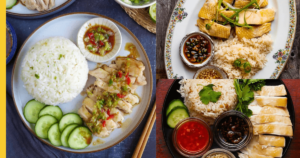Roti Kahwin or roti bakar, a snack so simple yet so enshrined in the daily rhythms of Southeast Asia, provides a culinary snapshot of the region’s gastronomic gusto. From the street-side vendors of Kuala Lumpur to the charming cafes of Jakarta, Roti Kahwin is a testament to the simple pleasures of Southeast Asian cuisine. Let’s embark on a flavorful journey to uncover the story of this toasty treat that’s more than just a piece of bread – it’s a slice of cultural harmony.
From Charcoal Grills to Modern Menus
The story of Roti Kahwin begins with the traditional kopitiam culture, primarily in Malaysia and Singapore, where the Chinese influence mingled with local Malay culinary traditions. The concept soon spread across neighbouring countries like Indonesia and Brunei, each adding their unique twist to this beloved dish.
While the classic version remains popular, Southeast Asian creativity knows no bounds, and Roti Kahwin has since adopted a multitude of flavours and combinations that showcase the region’s diverse palate.

The Art of the Perfect Toast
At its core, Roti Kahwin is disarmingly straightforward – bread toasted to golden perfection, often over a charcoal fire for that inimitable smoky nuance. Yet, the true artistry of Roti Kahwin is in its customization. A classic serving is generously spread with kaya – a luscious concoction of coconut milk, eggs, and sugar, fragranced with the sweet aroma of pandan leaves. The experience is heightened with a pat of butter that melts and pools into the kaya, mingling its salty richness with the jam’s sweetness.
The contrast between the warm, salty butter and the sweet, fragrant kaya is a testament to the balance of flavours that Southeast Asian cuisine is renowned for. It’s not just a treat; it’s a celebration of texture and taste that symbolises a perfect union, hence the term “Kahwin,” meaning “wedding” in Malay.

Boundless Varieties Across Borders
While the traditional Roti Kahwin is a masterpiece in its own right, the versatility of this dish is evident in the myriad variations found across Malaysia. Some versions feature a sprinkle of granulated sugar for added crunch, while others incorporate peanut butter, chocolate spread, or even savoury options like sardines or ham and cheese.
One of the most intriguing variants is the Roti Kahwin Telur, where an egg is cracked into a hole in the middle of the bread and cooked to perfection, resulting in a delightful combination of crispy bread and runny yolk. For the more adventurous palate, there’s even Roti Kahwin with Marmite or Vegemite, providing a tangy umami kick that contrasts beautifully with the bread’s sweetness.
While, in Indonesia, Roti Kahwin, where it is known as Roti Bakar, might be found with a spread of chocolate sprinkles (meses) or cheese, and sometimes even topped with condensed milk. Meanwhile, in the Philippines, a similar dish known as “pan de sal” is served alongside local coconut jam, giving a nod to the region’s shared penchant for sweet and savory combinations.
More Than Just Breakfast
Roti Kahwin isn’t just for breakfast; it’s an all-day affair. Whether it’s an early morning fuel-up, a midday snack, or a late-night comfort, this toasted treasure fits the bill. It’s a common sight to see Malaysians of all walks of life sitting at kopitiams, dipping their Roti Kahwin into soft-boiled eggs or savouring it alongside a steaming cup of kopi (coffee) or teh tarik (pulled tea).

The Toast of Southeast Asia
Whether you’re waking up to the bustle of Hanoi or winding down in the night markets of Penang, the presence of Roti Kahwin is a reminder of the region’s rich cultural tapestry. Each bite is an invitation to explore the flavours of Southeast Asia, to appreciate the beauty in simplicity, and to savour a shared heritage that continues to unite and delight millions. In the world of Southeast Asian street food, Roti Kahwin isn’t just a snack; it’s a warm, crispy embrace from a region known for its vibrant culinary spirit.
Article curated by Himavee Jayaweera.




